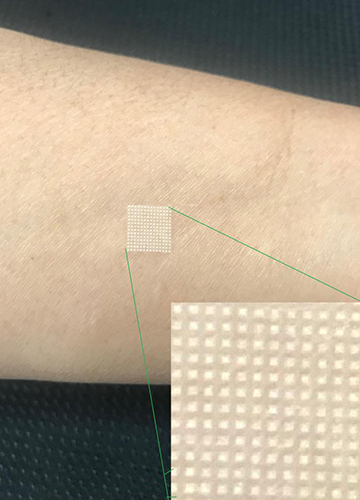It can be hard to watch your baby cry every time it gets vaccinated. The irritability and fever that ensue, though normal, often worry new parents. A newborn gets its first set of vaccinations within 48 hours of birth—Bacillus Calmette-Guerin, oral polio vaccine and hepatitis B. "A child is given at least 16 vaccinations in the first year. Immunisation is definitely a proven tool for controlling and eliminating life-threatening and infectious diseases. But every needle and syringe administration of vaccine can be stressful, both for the baby and the parents,” said Dr Hussain Ali P.V., general physician in the ministry of shipping.
In a bid to develop painless, easy-to-use injections, scientists around the world are working on new designs for vaccine delivery. This resulted in adhesive bandage-like patches. These patches, called microneedle or microarray patches (MAPs), consist of thousands of small needles, and when attached to the skin for some time, allow the vaccine to enter the body, and work like the conventional vaccine. In Europe, the first phase of trials has concluded and the technology has been declared "largely safe". Indian researchers are now trying to develop one that is locally sourced, efficient and cost-effective. Scientists at Hilleman Laboratories, a Delhi-based not-for-profit vaccine research organisation, are concluding the final stage of testing the device on animals. Human trials, once initiated, might take up to three years.
Hilleman's CEO Dr Davinder Gill says that with the needle and syringe administration of vaccine, which is a 160-year-old practice, only the circumference of the needle and the syringe has changed over time. "As an alternative route to enhance the vaccination efficacy, microneedles have been devised to target the rich network of immunologic antigen-presenting cells in the dermis and epidermis. Studies have revealed that vaccine delivery through micro patches have comparable or higher ability to induce an immune response than conventional vaccines,” he said.
The technology’s success would prove beneficial for India’s rural public, as it can be administered by health workers with minimal training, or even self-administered. "The concept of patch vaccines is excellent for mass immunisation," said Dr Jeeson Unni, paediatrician, Aster Medicity, Kochi. "After vaccination, the microneedles dissolve in the skin, and the used patches can be safely discarded as non-sharp waste. The vaccines remained potent in the patches without refrigeration for at least one year, circumventing the issues of cold chain maintenance. The only concern is maintaining records of immunisation. Since patch vaccines will be made available off the counter, there would not be any documentation of the immunisation shots."
Reports as per India’s AEFI (Adverse Events Following Immunisation) data state that there was a spike in adverse events in 2017. The database had recorded AEFI cases that caused rashes and related skin reactions and abscess, but the report specified that no deaths were attributed to vaccines alone.
Said Dr Mathew Pappachan, fertility specialist and clinical embryologist, Lifeline Hospital, Kerala: "Although adverse events following vaccinations are not very common these days, there have been cases of extreme side effects associated with vaccine administration—mostly attributed to inappropriate handling, contamination, production error or error of medical care. There are a lot of incidents of needle stick injuries. But most cases are not reported or are documented falsely to avoid litigation."
Increased thermostability, ease of use and safety are the focus points of the research at Hilleman. The Indian model will be able to administer 0.5ml of vaccine (standard dosage) as against 0.1ml in the western patch. "We have discovered a design which would allow us to administer doses up to 1.5ml at nominal cost. We are working with local component makers to produce the world’s cheapest microarray patch,” said Gill.
Does it mean, no more needle and syringe? According to Gill, though not all injectable drugs can be administered with MAPs, it is an option for many major vaccines and drugs. These include the flu, rabies and yellow fever vaccines, injectable polio vaccine, human papilloma virus (HPV) vaccine, tetanus-toxoid and measles-rubella vaccine. The product will also be usable for non-vaccine applications such as anti-retrovirals and as contraceptives.
The journey of developing and testing has not been all rosy though. Their initial design failed to deliver the required result. "Both setbacks and failures are part of any research and development project," said Gill. "Our biggest challenge moving forward will be to convince all stakeholders to shift to these innovative modes."
Furthermore, researchers in the US and Australia are now working on a nano patch. Vaxxas, an American startup, is testing this. Smaller than a micro patch, a nano patch has thousands of microscopic vaccine-coated projections on it. The patch can be applied using a finger or an applicator. The future of vaccinations is full of surprises and, not to forget, zero pain.



